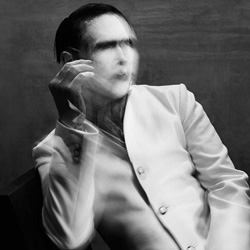 If a shock rocker can no longer shock, where does he go from there? In a ham-fisted way, that’s been the question plaguing Marilyn Manson for years. It’s been a long time since Manson was the willing and convenient boogieman, but there’s no doubt some part of him still wants to kick that beehive. Even when he tried to reinvent himself as a booted and suited dandy, the guy who declared himself to be the “God of fuck” was still lurking. The problem was that after awhile shock becomes predictable and Manson’s attempts to do so garnered increasingly diminishing returns. He has never stopped working and putting out records, but it seems like his former audience has put him into the back of the closet like a pair of JNCO jeans. Still, there’s been some early signs that his next record was going to be one worth hearing. And so the world turns with a bit of interest to Manson’s latest record, his band’s ninth, The Pale Emperor (Loma Vista Recordings).
If a shock rocker can no longer shock, where does he go from there? In a ham-fisted way, that’s been the question plaguing Marilyn Manson for years. It’s been a long time since Manson was the willing and convenient boogieman, but there’s no doubt some part of him still wants to kick that beehive. Even when he tried to reinvent himself as a booted and suited dandy, the guy who declared himself to be the “God of fuck” was still lurking. The problem was that after awhile shock becomes predictable and Manson’s attempts to do so garnered increasingly diminishing returns. He has never stopped working and putting out records, but it seems like his former audience has put him into the back of the closet like a pair of JNCO jeans. Still, there’s been some early signs that his next record was going to be one worth hearing. And so the world turns with a bit of interest to Manson’s latest record, his band’s ninth, The Pale Emperor (Loma Vista Recordings).
Part of the reason why Manson’s music has felt so stagnant in recent years is that on a certain level you always know what to expect. So it’s a bit surprising to find that Manson has indeed shaken things up. The Pale Emperor is the first record since 2008 to not feature work from longtime collaborator Twiggy Ramirez. In his seat instead is Tyler Bates, who recently worked on the score for Guardians of the Galaxy. The changes are immediate and noticeable as the record largely dispenses with the hard rock–industrial hybrid that has been Manson’s bread and butter since the early days for a stripped down blues-based sound. There are the occasional electronic flourishes, but for the most part the man in black has the blues. Manson sounds fairly natural in this new environment, with less bellowing from the depths of hell and more restrained crooning. There are a few instances of Mechanical Animals-era glam, only with the more sparse approach the band takes where the bass and the drums do the heavy lifting. Possibly the heaviest blues sound is found on “Birds of Hell Awaiting,” where the track almost gets away from Manson vocally, but with the commitment and the way everything seems to lock in, the song works in a way it probably shouldn’t.
Lyrically, The Pale Emperor is a mix of Manson’s usual overwrought grad-school level of delving into morality, war, religion, mythology, and folklore, but this time around he also lets the mask of Marilyn Manson slip a little bit, with some human vulnerability peeking through. The record also shows Manson unafraid to slide in humorous moments like the pun of “Warship My Wreck.” There are still the attempts to poke the bear, but it feels like there’s more of an effort to be a person rather than a character, the mantle of “Pale Emperor” not withstanding.
The Pale Emperor is the most engaged and focused Marilyn Manson record in ages. However, there are some hiccups. Some of the songs strain to justify their extended running times; seven of the 10 songs are more than five minutes long, so they feel like they need a good edit. Also, the best Manson songs have always merged atmospherics with earworm choruses, and those lyrical hooks are missing. While there are a bunch of really strong performances, there’s nothing as instantly iconic as “The Beautiful People” or as catchy as “Dope Show.” You could view it as Manson’s stance against playing in the pop show or simply a missed opportunity. Still, there’s no denying that The Pale Emperor is a strong return for Marilyn Manson, both the man and the band.

Your Comments